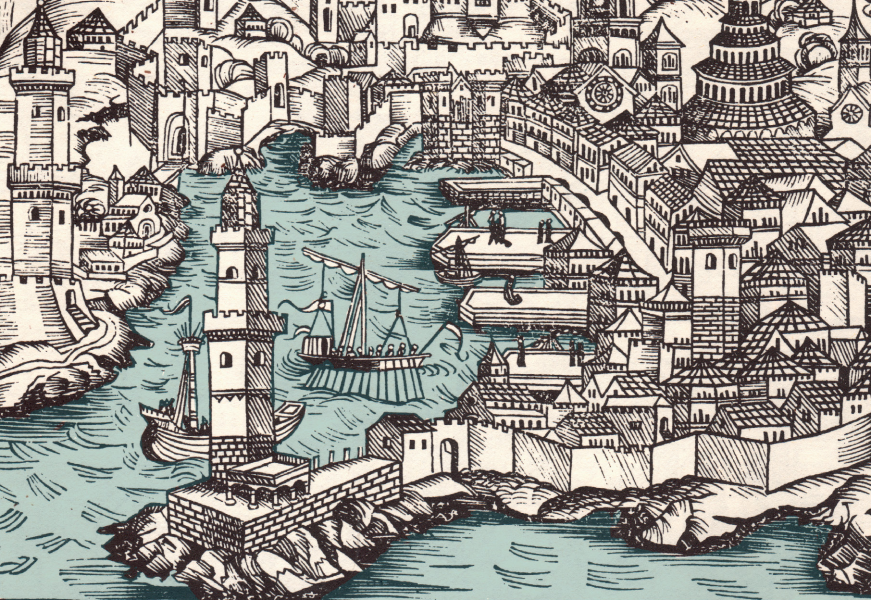Sottoripa,fronte del porto
– ripa maris

Nel 1493, Michael Wolgemut rappresenta Genova con le sue mura, i moli in pietra e le arcate di Sottoripa nascoste da botteghe e magazzini // In 1493, Michael Wolgemut depicted Genoa with its walls, stone piers and the arches of Sottoripa concealed by the many shops and warehouses
Il porto nel medioevo è un emporio laborioso che si affaccia sul mare
I più antichi resti archeologici del porto giunti fino a noi risalgono al XII secolo, quando si comincia a circoscrivere un tratto di costa mediante il posizionamento, nel basso fondale marino dell’ansa naturale detta del Mandraccio, di pietre squadrate, così da garantire un miglior riparo. Il nome forse deriva dalla somiglianza del disordine creato dalle barche attraccate alla costa con quello delle mandrie di bestiame rinchiuse in un recinto stretto (dal latino ‘mandra’, il recinto).
All’epoca, la riva è fatta prevalentemente di sabbia; i genovesi, oramai, si sono avvicinati con le loro abitazioni al mare, creando una linea di confine fatta di pietre e legname; una palazzata quasi continua, ad arco di cerchio, che ha alla sua base una ininterrotta sequenza di portici sotto ai quali organizzano le loro attività artigiani, commercianti e venditori, tutti legati al porto come unico strumento di sopravvivenza e, nel migliore dei casi, prosperità.
I primi sono indispensabili nella costruzione delle galee, velieri e altre piccole imbarcazioni; servono uomini capaci di tagliare le assi di legno seguendo i modelli esatti che vengono tramandati gelosamente di generazione in generazione; servono fabbri per produrre chiodi e gli attrezzi indispensabili alla lavorazione; serve chi prepari vele, corde e tutto quanto sia utile al varo di una nave, alla sua manutenzione, alla sua riparazione se una tempesta o un attacco dei pirati ha causato danni non sanabili durante il viaggio.
In questo fronte di edifici, troviamo in sequenza anche depositi delle merci sbarcate o in partenza: deve tutto stare vicino alla riva, perché ogni spostamento può essere effettuato solo a fronte della fatica dell’uomo.
Sottoripa harbour front – Ripa Maris
In the Middle Ages, the port was an industrious emporium overlooking the sea.
The oldest surviving archaeological remains of the port date back to the 12th century, when a stretch of the coastline was enclosed with large square stones placed in the shallow waters of the natural inlet known as the ‘Mandraccio’ to create a safe harbour. The name is said to stem from the similarity between the cluttered boats moored to the coast and the herds of cattle (‘mandria’) confined in a small corral.
At that time, the shore was mainly made up of sand; the Genoese had now moved their dwellings closer to the sea, building a boundary made of stones and timber: an almost continuous, arched construction with an uninterrupted sequence of porticos, under which craftsmen, traders and vendors organised their activities, all linked to the port as the only means of survival and, in the best of cases, prosperity.
The first were essential in the construction of galleys, sailing ships and other small boats. Skilled men were needed to cut wooden planks according to exact designs jealously handed down from generation to generation, blacksmiths were needed to make the nails and the tools necessary for construction and sailmakers were needed to prepare sails, ropes and everything required to rig, service and repair ships when they suffered damages caused by storms or pirate attacks.
The harbourfront also housed a series of warehouses for incoming and outgoing goods: everything had to be as close as possible to shore, since all goods were carried with great effort by strong-armed dock workers.
